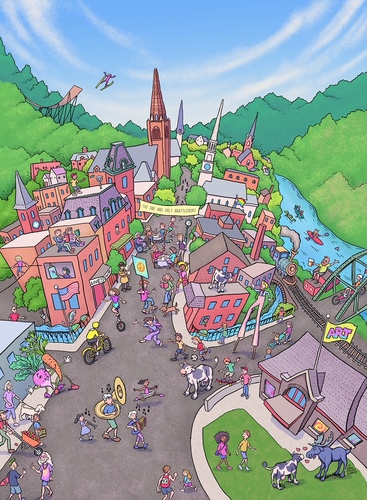BRATTLEBORO — As an undergraduate at Pratt Institute in Brooklyn, New York, John Steven Gurney discovered his love for children's books. He has illustrated more than 100 children's books over the years.
But there, he found that “children's books were only some of the things I wanted to illustrate,” said the artist, who has also has worked on fiction book covers, editorial illustrations for magazines, puzzles, and advertising posters.
His journey from Brooklyn to Brattleboro came after living in Brooklyn for 17 years with his wife, Kathie, and his children, then 6 months and 3-years-old.
“[We knew that] someday we didn't want to raise kids in the city,” he said. “And we knew we wanted to leave at some point.”
The family would vacation at Lake Willoughby in the Northeast Kingdom and stop by Brattleboro on the way up. “We really fell in love with the town,” he said.
Gurney said since his work was freelance, he could choose to be anywhere, and that's why he picked Brattleboro.
“And I'm glad we did,” he said.
Finding his inspiration
Gurney is currently illustrating and writing “Fuzzy Baseball,” a series of graphic novels for children published by Papercutz.
In each book, the Fernwood Valley Fuzzies play a different team, such as ninjas, robots, and dinosaurs. “Even though baseball is the connecting theme, I like to think of these books as ensemble comedies rather than sports stories,” he said.
Gurney got his inspiration based on his experience growing up outside of Philadelphia, where the Phillies were perpetual losers in the '70s but ended up winning the World Series in 1980. “By 2004 I was living in Vermont, and I had a similar experience as a Red Sox fan,” he said.
He explains how his experience cheering for his home team helped him with his writing.
“That experience of rooting for the underdog who wins big was one of the driving forces behind the first book in the series,” he said.
First love: illustrating
Gurney said that at the same time as he was honing his craft with illustration, he was constantly writing. “As an undergraduate, my senior project was a comedic-fantasy graphic novel that I wrote and illustrated,” he said. “It got some interest, but was never published.”
It took him almost 20 years to get his first book published. “It wasn't until I had kids, and spent hundreds of hours reading bedtime stories, that I got a better sense of the genre,” he said.
“My first love is illustrating. When I write a story, I'm writing it so I can illustrate it.” Gurney said.
He said he loves using his illustrations to bring his characters to life.
When he writes a story, “it always starts by me sketching the characters, and then as the character comes to life I imagine what kind of a situation they would be in, and that's the core of the story.”
He said he loves engaging the reader: “I want to give them something to care about, so they keep turning the pages.”
Gurney said he likes to set expectations, but also surprise readers.
“I love the ability to put words in my characters' mouths,” he says. “Ideally, a character should communicate volumes just by their appearance, body language, and expression. But having them speak brings it to a whole other level.”
From analog to digital
Gurney said the process of illustration has changed a lot in the past couple of decades.
“Full color reproduction was very expensive and rare, so most of the interiors of books and magazines were either black and white, or one color with black,” he noted.
He said the first big change was the fax machine in the late 1980s.
“It was amazing to be able to fax sketches to the client, rather bring them into the office. Or FedEx sketches to another state,” he said.
Although technology was changing the process of illustrations, and he did begin to use digital tools like Photoshop for some aspects of his work, Gurney would finish his work traditionally.
For some of the samples on his website, he has used an Apple iPad with an Apple Pencil, using ProCreate, an illustration and animation app.
“The biggest difference the digital age has wrought is that digital media has taken the place of print media,” he said.
Advice from a pro
Gurney is finishing his book Fuzzy Baseball #5: Fuzzy BaseBALLoween, expected to be out this fall.
After 30 years of illustrating, Gurney earned an master's degree in illustration from the University of Hartford so he could teach at a college level. He plans for future books and workshops, as well as presentations at elementary schools.
He gives some advice to aspiring writers: “As an author, you have to strike a balance between being true to your own vision and listening to feedback from folks who are familiar with the medium.”
